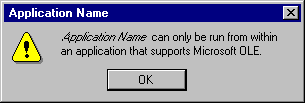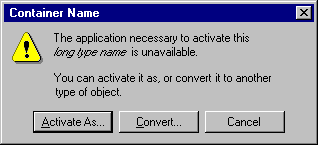
Display the following messages to notify the user about situations where an OLE object's application is not accessible.
Some OLE objects are designed to be used only as components within a container and have no value in being opened directly. If the user attempts to open or run an OLE object's application that cannot run as a standalone application, display the message box shown in Figure 11.39.

Figure 11.39 Object's application cannot be run standalone message
An object's application can be running, but busy for several reasons. For example, it can be busy printing, waiting for user input to a modal message box, or the application has stopped responding to the system. If the object's application is busy, display the message box shown in Figure 11.40.

Figure 11.40 Object's application is busy message
If the user attempts to activate an object and the container cannot locate the requested object's application, for example, because the object's type is not registered or because the network server where the application resides is unavailable, display the message box shown in Figure 11.41.

Figure 11.41 Object's application is unavailable message
Choosing the Activate As button displays the Convert dialog box preset with the Activate As option and a list of current types the user can use to associate with activating the object. Choosing the Convert button displays the Convert dialog box with the Convert option set, and the list of types the user can choose to change the type of the object. Ideally, an application that registers the type should be able to read and write that format without any loss of information. If it cannot preserve the information of the original type, the application handling the type emulation displays a message box warning the user about what information it cannot preserve and optionally allows the user to convert the object's type.
If a container supports inside-out activation for an object, display this message when the user tries to interact with that object, not when its container is opened. This avoids the display of the message to the user who only intends to view the content.